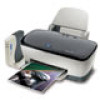Epson Stylus C80WN Product Support Bulletin(s) - Page 20
Windows 2000 Instructions
 |
View all Epson Stylus C80WN manuals
Add to My Manuals
Save this manual to your list of manuals |
Page 20 highlights
EPSON PRODUCT SUPPORT BULLETIN Date: PSB #: Reference: Product(s): Subject: 11/1/2002 Originator: JAM PSB.2003.01.003 Authorization: N/A Total Pages: 5 Epson Stylus Color C80WN Enabling Wireless Encryption Protection (WEP) for C80WN and Windows 2000 This bulletin was created to inform you of a procedure to guide you through configuring WEP on the C80WN Print Server system. Windows 2000 Instructions Requirements: You will need the "SSID" and "IP Settings" for your wireless network. The SSID information is available in the properties of the wireless Ethernet interface on the computer. The IP settings can be viewed by typing IPCONFIG from the command prompt on the computer. Refer to the Access Point/Base Station's documentation for the SSID if necessary. Enabling WEP Encryption: Note: To successfully enable WEP, the main item on the Print Server and Access Point/Base station CONFIGURATION menu is the type of WEP key - "Open" or "Shared" Key Type. If The Epson Wireless Print Servers firmware is version 3.91 or earlier, the print server defaults to Open with no selection for Shared key type. Some Access Points, Proxim for example, default to Shared key type (other manufacturers may also) and would need to be set to Open key type. Refer to the documentation for your Access Point hardware to determine where the setting for the Key Type is found. If the Key Types are not the same between the print server, computer and Access Point, the Host and Print Server will not handshake properly. Even though all settings appear to be correct, communication fails and a time-out occurs without any displaying any error messages. Additionally, after the Print Server, Access Point and wireless computer are configured on the same IP address segment and communicating properly, the printer/print server's TCP/IP address must be changed to a TCP/IP address within the same IP address segment in order to communicate and print. The Subnet Mask and Gateway address must match also. Page 1 of 5















